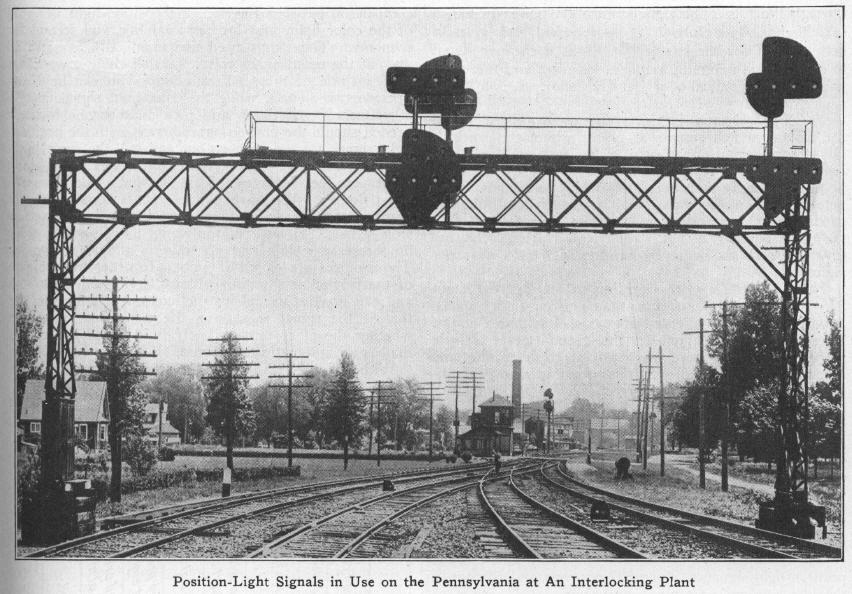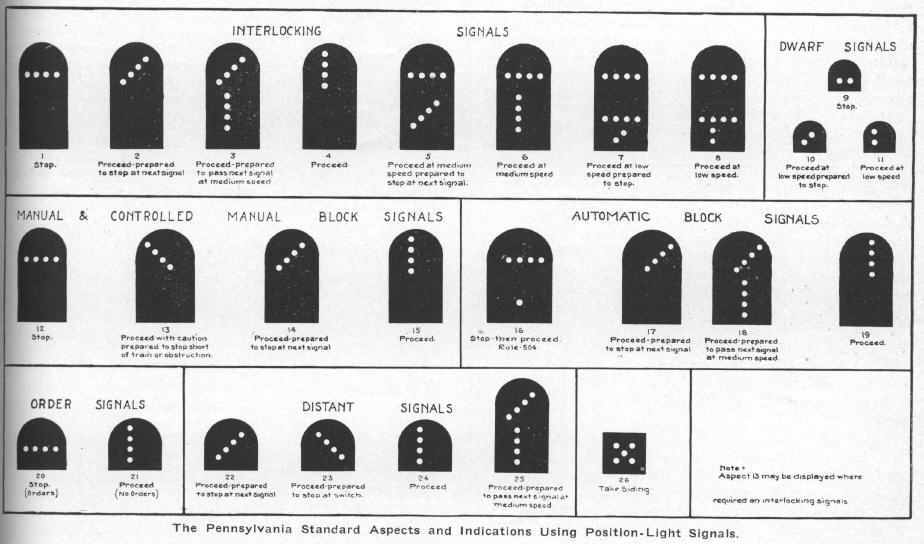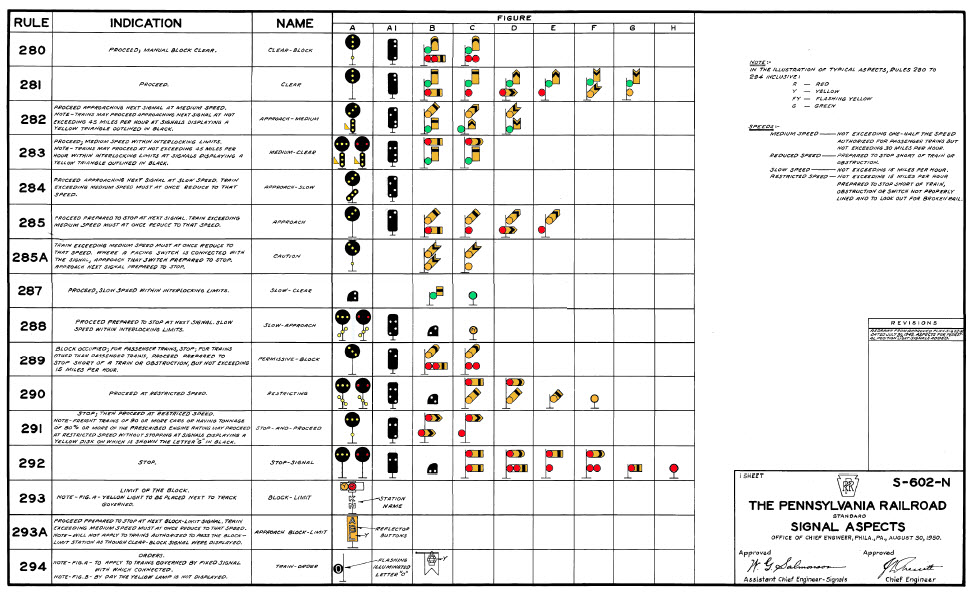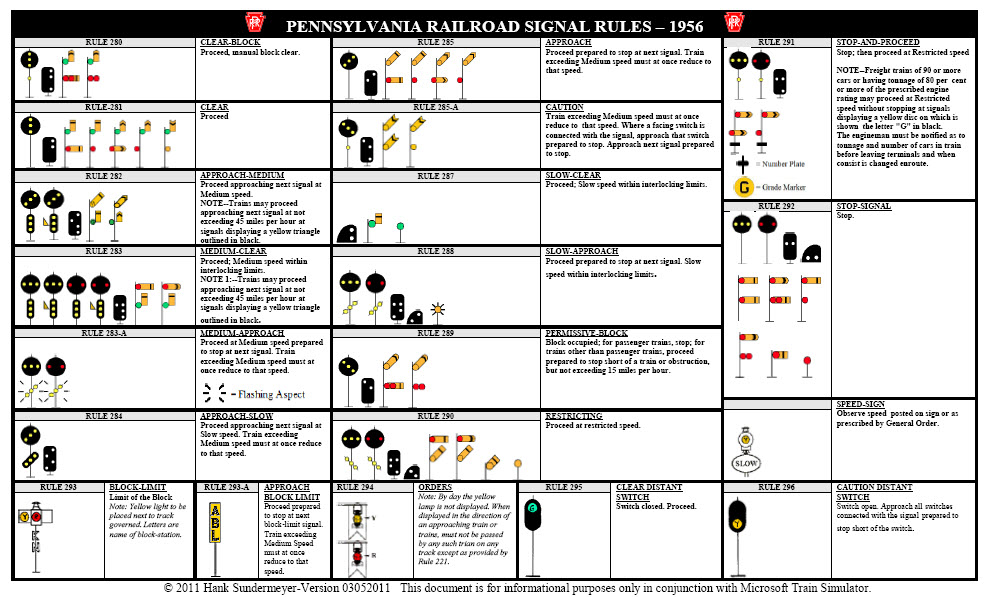I should first mention that if you are looking for a great technical history on the PRR PL you can find one at railroadsignals.us and there you can learn all about the original 4-lamp position light system, sometimes known as "tombstone signals" due to one of the variations of backing plate.
The 4-lamp PL's were an almost literal translation of the semaphore blade positions into lights. If you are wondering why the PRR didn't just go with using the all color "night" indications, the reason is because reliable high intensity light sources (and mains power) were not yet available yet. Searchlights and position lights could make use of low wattage bulbs that could run for long periods even on battery power.
Looking at the chart above we see all of our familiar favorites including / over | approach medium and --- over | Medium Clear, but we also see some interesting deviations from the later system, most significantly --- over / Medium Approach. Also, "Slow speed" indications were handled by a little two lamp analogue of a subsidiary signal on a third head. These consisted of a --- over --- over / indication, which I believe is Restricting and a --- over --- over |, which plays the role of a Slow Clear or Slow Approach.
Sorry for the small chart there, but I wanted to show how the 1950 version of the PL system compares with the older semaphore system, still very much still in use at that time at various locations around the vast PRR. One interesting thing is how indications that involved the shape of the semaphore blade (Caution and Permissive Block) had to make use of the upper head \ indication. We can also see why the Semaphore system had no Approach Slow as Y/Y was the night indication for Caution.
 |
| Prototype PL's, trying so hard for a third head. |
From the 1950 chart we can see how PRR used an exclusively 2 head Semaphore system, which in turn lead to the 2-head PL system. The Standard Railroad of the World was not about to go around throwing money at unnecessary signal heads, but as the above picture shows, signal engineers were not unaware that the PRR's use of only two heads presented a few limitations. With the subsidiary signal available for slow speed movements, --- over / Medium Approach was an obvious choice since it was not available as a semaphore since R/Y was reserved for Restricting. However when the PRR PL system was finalized with 3-lamps and 2 heads, Medium Approach had to go for a combination of Restricting and Slow Approach for slow speed movements. If you are wondering how one diverged to stop, spend some time on the LIRR as they still use the original PRR system where one diverges over Approach after first passing Approach Medium with the theory being Approach Medium gets you down to Medium Speed and Approach requires traveling at Medium Speed.
Also making its appearance in the 1950 version of the PRR PL system was the Limited Speed triangle, which allowed for higher speed turnouts (45mph vs 30mph) without having to spend more than 30 cents on a signaling upgrade. Limited speed turnouts started seeing wider use in the 1930;s and 40's in the electrified region where the higher performance of electric locomotives and multi-track main lines made efficient crossing over more of a necessity.
I should also note at this time that the ever stingy PRR applied a backing plate only to the | on the lower head because it was thought that any Engineer approaching a signal at Restricting or Slow Approach, would be going slow enough to see the indication even in bright sunlight.
This finally brings us to the 1956 modification of the PRR signal rules to finally include Medium Approach, first cut from the lineup over 40 years earlier. What changed was that flashing relays were finally considered reliable enough for use in safety critical signal applications. This allowed the PRR to overload the lower head / so that the speed would be upgraded to Medium when flashing. This method of Medium Approach would be wholeheartedly adopted by Conrail in color light R/*Y* form as a way to, what else, save money over the three head R/Y/R Medium Approach used by the New York Central and Reading systems,
So the only thing left to go over are those funny signals with the extra marker light below them or \ indications on the upper head, which I will do...in another post that focuses specifically on manual block signaling in the United States. Sorry :-P




No comments:
Post a Comment